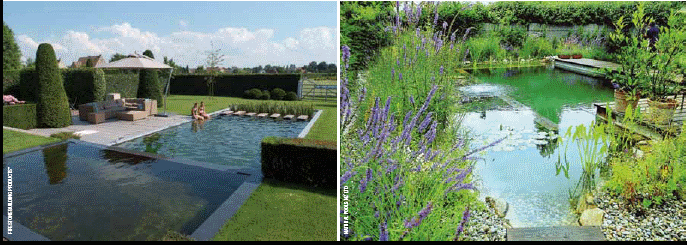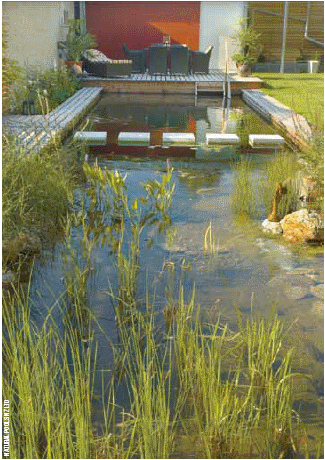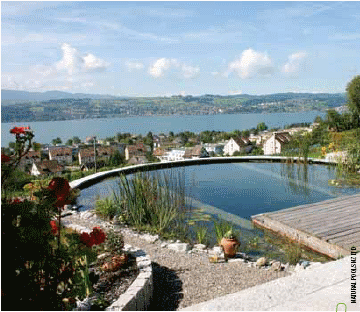Natural Swimming Pools – chemical free
Tell me more…

Filtering marsh area
Sufficient plants
No matter what they say, no filter system is able to do what plants can do, i.e., absorb phosphates. Low-maintenance and fast-growing plants are well suited for marsh bed filters. All pond plants are suitable but fast growing plants grow faster because they absorb more foodstuff.
Preferably in the sun
In most cases the sunniest location possible will be chosen for the swimming paradise. Swimmers expect heated water and most water plants require lots of light in order to thrive. Larger ponds warm up more slowly than smaller ones but maintain a much more stable temperature. Solar heat is stored in them which makes them comfortable to swim in even during cooler summer days. The colour of the liner also affects temperature.
Liners
In practice, a 1mm thick tested rubber liner for pond applications (such as Firestone Rubber Pond Liner) that is 100% safe for bathers and organisms is used. Rubber liners have an exceptionally long lifespan. The better will last more than 50 years in our climate. The liner can be installed in one piece, but can also be adhered to a concrete wall and the seams can be created in situ using the cold vulcanisation method. Application is possible both onto concrete constructions and directly onto synthetic pipes, lighting fittings, etc. This is often important in natural swimming pools.

Special moulded liners
It is possible to create ponds with few or even no folds. Often the swimming pond walls will be erected in concrete or concrete blocks. In order to create perfectly square angles and an absolutely watertight transit area, partially vulcanised liners are available, or ‘form flash’, which is malleable. It has to be thought of as a liner that temporarily acquires the characteristics of chewing gum.
Over time the liner acquires the same characteristics as a rubber liner. It therefore vulcanises in situ into the desired shape, accelerated by the splice adhesive. The adhesive is also applied to the liner. After around 10 minutes drying time, the malleable sheet is moulded into the right shape and glued to the liner, after which the entire surface is thoroughly rolled out. As a temporary protection during the reaction (transformation into liner) the seams are subsequently finished with lap sealant. The major advantage of this process is that the desired shape can be created in situ, without tension.
Finishing touches
The swimming pond and its surroundings can exude opulence or restraint, depending on what clients are able to afford. Have an eye for playful details: a statue or other work of art can work wonders; a water slide is appreciated by the children. Go for naturally warm materials such as wooden duckboards and natural stone whenever possible. Oxygen is important to every water feature. A waterfall, a fountain head or a pierced stone, connected to a pump help to keep the oxygen content level. The water that returns from the filtering marsh area is very low in oxygen (used by nitrifying bacteria) and should be oxygenated before running back into the pond. Remember this when designing the swimming pond. Attractive effects can be obtained using waterfalls, fountain heads and bubbling stones and they are useful to the organic balance of the pond.
Beneficial and other wildlife
Mosquitoes and their larvae are unlikely to survive in a swimming pond and consequently will not be a nuisance; there are too many natural enemies such as dragonflies and coleopterans larvae out to get them. Water fleas (small crustaceans that have nothing to do with real fleas) are very useful and float in the water. They have a diameter of 1 to 2 mm and filter the water crystal-clear. We ought to thank them for it. Beautiful insects such as dragonflies fly over the water; the pond is their habitat and they are absolutely harmless to humans (they also catch flies and mosquitoes). Frogs are a part of pond life. Besides, their larvae – or tadpoles – eat the algae that grow on the pond walls.
Swimming pond lighting
Lighting provides longer enjoyment and additional atmosphere. In the area of lighting we are at the beginning of a revolution. Fibreglass cables safely bring light to sites that are not so simple to reach, such as those under water. Fibreglass cables remain rather expensive however, meaning their general application is less likely. LEDs (short for light emitting diodes) are getting cheaper and have a number of major advantages. They are colourfast and the colours do not change when ageing as is the case for other light sources. Electricity consumption is very low (approximately one fifth of a halogen spot with the same light output). The number of burning-hours is over 100,000. They are low tension, which makes LEDs safe and very well suited for gardens, ponds and swimming ponds. They also give off a kind of diffused light.
In conclusion
In Europe and the UK natural swimming ponds or pools have been around for some time and have been approved by some local bodies for use as public facilities underscoring their safety for swimmers who may be concerned about bacterial content. So, throw out those chemicals and get in the swim – naturally.
The advantages of a natural pool
- Chemical free water that is pure, clear and soft on the skin
- Low heating costs due to natural and efficient warming
- Low maintenance that is less costly
- Similar to river or lake swimming encouraging aquatic flora and fauna – an harmonious blend of plants and wildlife
- More environmentally friendly – an ecologically balanced self- cleaning bio-system drawing abundant life to a garden
The frog prince
Frogs are a part of pond life. They are an endangered species, often referred to as ‘the canaries of the planet’. Their declining populations do not auger well for any of us. Frogs are both predator and prey, an invaluable – if undervalued – part of the ecosystem. A natural swimming pool could help save a small frog population and contribute to the reversal of this dangerous trend.
Images: Natural Pools NZ Ltd; Firestone Pondgard Lining Ltd (Cosio Industries Ltd)



Oh my gosh – what a fabulous idea! We inherited a pool with a house we bought and have spent lots of time and money on chemicals and filtration. I am enthusiastic to see if we can convert to a natural pool.
Hi Nicki,
Thanks for your message. Just send us some photos and more information about your existing pool and we can see if we can convert your pool into a natural pool. Have a look on our website and give us a ring if you have more questions.
Regards Alex
info@naturalpoolsnz.com
Dear Nikki
We are the NZ distributors for Firestone Liners. You could view the website http://www.pondco.co.nz, this is the new web site for the companies mentioned in this article (Sandco and Earth in Design aka Palmco). They have just completed a NSP in Kerikeri for a health spa lodge.
Another company to try is wetlandpools.co.nz
Best regards, Vaughan